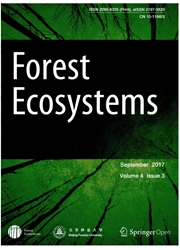

 中文摘要:
中文摘要:
maleated 聚丙烯(MAPP ) 的粘弹性的性质修改了木头面粉 / 聚丙烯 composites (世界和平理事会) 被一个压缩压力松驰方法和动态机械分析(直接存储器存取) 调查。到聚合物比率(40:60, 60:40,和 80:20 ) 和五 MAPP 装载层次(0, 1, 2, 4 和 8%) 的三根木头被用来在 MAPP 世界和平理事会的粘弹性的性质上学习他们的效果。结果显示出那:1 ) 到聚合物比率的更高的木头通信更高为未修改的世界和平理事会强调松驰层次。有 MAPP 的修正在更高的木头在 MAPP 世界和平理事会的压力松驰上有明显的效果到聚合物比率(60:40 和 80:20 ) ,但是几乎不在 40:60 木头完成到聚合物比率。为木头装载水平到 60:40 的聚合物比率的最佳的 MAPP 出现在 1% 点;2 ) 存储模量在,为 80:20 木头为木头装载 1% 的水平到 40:60 和 60:40 的聚合物比率到聚合物比率的 MAPP 到达它的最大值,更高的存储模量在装载层次的更高的 MAPP 被观察,它与压力松驰结果相当一致。结果建议 MAPP 的合适的装载水平在更高的木头在世界和平理事会的粘弹性的性质上有积极效果到聚合物比率。装载的过多的 MAPP 将导致不利效果。
 英文摘要:
英文摘要:
Viscoelastic properties of maleated polypropylene (MAPP)-modified wood flour/polypropylene composites (WPC) were investigated by both a compression stress relaxation method and dynamic mechanical analyses (DMA). Three wood to polymer ratios (40:60, 60:40, and 80:20) and five MAPP loading levels (0, 1, 2, 4 and 8%) were used to study their effects on the viscoelastic prop- erties of MAPP-WPC. The results show that: 1) higher wood to polymer ratio corresponds to higher stress relaxation levels for unmodified WPC. The modification with MAPP has an obvious effect on the stress relaxation of MAPP-WPC at higher wood to polymer ratios (60:40 and 80:20), but almost no effect at the 40:60 wood to polymer ratio. The optimal MAPP loading level for the wood to polymer ratio of 60:40 appears at 1%; 2) the storage modulus reaches its maximum at a MAPP loading level of 1% for wood to polymer ratios of 40:60 and 60:40, while for the 80:20 wood to polymer ratio, a higher storage modulus is observed at higher MAPP loading levels, which is quite consistent with the stress relaxation results. The results suggested that a suitable loading level of MAPP has a positive effect on the viscoelastic properties of WPC at higher wood to polymer ratios. Excessive MAPP loading would have resulted in adverse effects.
 同期刊论文项目
同期刊论文项目
 同项目期刊论文
同项目期刊论文
 期刊信息
期刊信息
